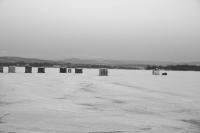Ice Is More Fun When We Play It Safe
By Mike Cameron
|
The cold weather has finally arrived with below zero temperatures and biting winds.
For ice fishermen, ice boaters, ice touring skaters and others this is a god-send.
After waiting through the normal ice-up period of early January and seeing folks in shorts and tees back then, the wait has been a long one especially for people who depend on the ice for their winter business and winter recreation .
For most of us who enjoy the “hard water” sports we realize that under that ice sheet lies plenty of water to swallow us up if we fall through and that’s just the top of it.
With sub-zero air temperatures and water that is in the process of freezing, it doesn't take a scientist to figure out that if you go through you may not survive.
People dislike being “preached to” about safety but it might serve the greater good to look at some facts about safe ice/unsafe ice and perhaps we can provide some useful information.
The 2” Rule
There is no 2” rule, but let’s use this as a guide and starting point. The U.S. Coast Guard and Vermont Department of Fish and Wildlife posts safe ice measurement standards on their website.
The Cold Regions Research Laboratory in Hanover N.H. has another excellent informational posting on their site. Here is a synopsis from both that can help us all to better understand the nature of safe ice.
Ice related accidents resulting in injury or death are usually caused by “poor judgment and poor decisions based on inadequate information,” according to USCG data. They encourage people to “wait to walk on the ice until it is a minimum of 2-inches thick. Some prefer 4-inches of ice. We are describing “clear, hard ice.” Snowy ice is less solid and sturdy. River ice has currents still active under the surface. Be aware of river mouths, points of land, bridges, islands, reefs and spring holes. Lake bridges are also an area where weak ice can be found near the piling. For folks who feel that this information is redundant we politely disagree. It’s better to think about it now than while you are on your way to the bottom of the lake with a spud in your hands wondering what went wrong. At this point only you and the fish will know.
New Hampshire Fish and Game officials urge ice sportspersons to be aware of the fact that “ice safety saves lives.” It’s as simple as that.
They lay out the depth parameters for safe ice activities as 4 to 6-inches of clear hard, new, ice as being capable of supporting a “few well dispersed persons.”
6 to 7-inches for small on-foot group activities and at least 8 to 10-inches for snowmobile/ATV activities.
Given this sample from scientists who study ice formation for a living including antarctic and polar ice, we would be well served to heed their recommendations.
It is always a good idea to carry a length of rope, (life-line) that can be thrown to a person who has fallen in. Ice spikes consisting of two handles with a steel spike in each (like small ice picks), connected with a lanyard can help you to crawl back on the surface if you fall into a weak spot in the ice.
A personal flotation device is also not a bad idea especially late in the season when the ice begins to rot from spring sunshine and rain. Carry a safety whistle.
Let people at home know where you will be. Carry a cell phone and if you are on the ice alone the above is even more important.
Being close to other people on the ice is the best bet for safety.
Finally a word about heated ice fishing shanties, they need to be well ventilated to prevent carbon monoxide poisoning.
The big freeze has finally come to the Champlain Valley and now we can get out on our lakes and ponds and really enjoy what the Vermont winter has to offer. Doing it safely and with a little planning makes it even more enjoyable in the long run. Here’s to full buckets and good eating!

